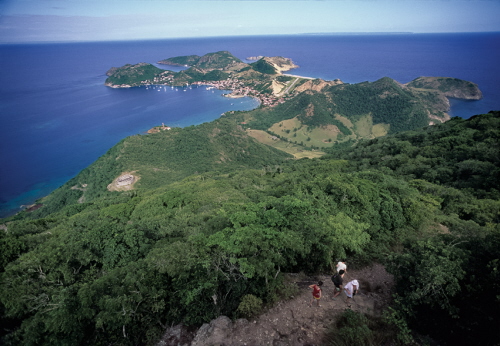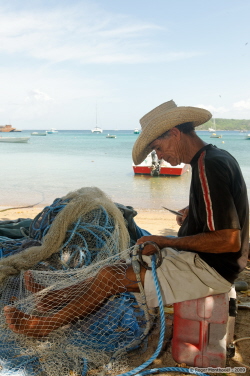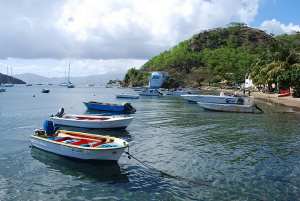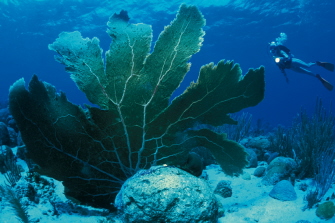By Susan Farewell

If you’re wondering where Les Saintes are, you’re not alone. Lots of people have never heard of them. In fact, these tiny islands (full name, Iles des Saintes) don’t even show up on most maps of the Caribbean and if they do, they’re mere specks. On top of that, they’re rarely featured in the glossy travel magazines and their websites. This might have to do with the fact that there are only a handful of places to stay and they don’t have all the bells and whistles so many of the more popular island resorts have (think waterslides, golf courses and sprawling fitness centers). They’re also not as coiffed as some of the heavily-marketed-to-tourists islands are.
But they have the raw Caribbean attractions—beautiful water, beaches and wraparound island scenery. And they have a distinct personality: very French (translation: great food).

A little archipelago of eight volcanic islands, Les Saintes lie seven miles south of Guadeloupe. Many visitors and residents say the main island, Terre-de-Haut, is what St. Barts used to be like (with prices a fraction of the cost). Others call Terre-de-Haut, with its sugarloaf mountain, a mini Rio. And everyone seems to agree on some level that Les Saintes are Le Dernier Paradis (The Last Paradise).
Many of the locals, known as Saintoise, are fair-skinned and can trace their lineage to Breton (pirate) settlers. They’ve got a West Indian-wide reputation for being great fishermen and sailors. Some wear a traditional white hat that looks like a parasol, patterned after one said to have been brought here ages ago from the Far East.
Lots of vacationers discover Les Saintes on day trips from Guadeloupe, inevitably wishing they had more time. Best to stay several nights, as much as a week , so you can really relax and enjoy the local culture. While there’s not a long list of things to do, there’s enough to break up lazy days on the beach.
The Must-do List
There are only two inhabited islands in the archipelago and Terre-de-Haut is the heart. Though tiny --just three miles long and two miles wide—it’s where you’ll find the most “attractions,” lots of restaurants, as well as the only real hotels in Les Saintes. It’s also where most of the locals live, many in red-roofed white-washed houses with bright red or blue doors and frilly gingerbread.
• Le Bourg. Terre-de-Haut’s main town crowds around a C-shaped harbor that screams photo-opp to every visitor. Best time to visit is in the morning when islanders congregate in the main square to people-watch and gossip. The main street is lined with candy-colored houses, funky shops displaying French fashions, galleries, and bistros serving everything from thin-crust pizza to grilled fish minutes out of the water. Most fascinating is the waterfront market where you’ll find all sorts of unrecognizable fruits and vegetables and the village’s pharmacies, neatly displaying French cosmetics and creams (pour les yeux, les mains, la visage). funky shops displaying French fashions, galleries, and bistros serving everything from thin-crust pizza to grilled fish minutes out of the water. Most fascinating is the waterfront market where you’ll find all sorts of unrecognizable fruits and vegetables and the village’s pharmacies, neatly displaying French cosmetics and creams (pour les yeux, les mains, la visage).
• Fort Napoleon. You expect to find forts on many Caribbean islands and this one, though never used in war, is the island’s top attraction. Propped up on a hill, east of town, it was built by the French to protect Guadeloupe from the English in the 18th century. Along with barracks and former prison cells (and a population of iguanas), there’s an impressive exhibit of the world’s greatest sea battles. In addition to its history, it’s also home to a museum of modern art, showcasing some 260 contemporary paintings along with a botanical garden. Plan to visit early in the day (hours are 9-12:30). visit early in the day (hours are 9-12:30).
• La Chameau. "A view and a half” is how I overheard one tourist describe the scenery from La Chameau , the highest point on the island (1,014 feet). Allow yourselves two hours to climb the steep slopes to the peak which is crowned by a stone citadel. Once on top, you won’t be able to take your eyes off the view--not only of Terre-de-Haut, but the seven other islands in the archipelago.
• Beaches, semi-nude (some nude), abound. Some are scraped out of cliffs, others are bookended by lava sculptures. Some are social, others are very quiet. One of the most popular with locals and visitors alike is Plage de Pompierre northeast of town, which is backed by palm trees. Southwest of town, Anse du Pain-du-Sucre has two semicircular beaches by the oft-photographed Sugar Loaf Hill. The nearby Anse Crawen on the west coast is a legal nudist beach. Though too rough for swimming, Grande Anse is a great place to plant yourselves and watch the ferocious surf.
• Water sports. Some visitors come here simply for the diving. There are a couple of local outfits that rent tanks and oth er gear and arrange excursions to over a dozen dive sites. Snorkeling right from the shore is quite fruitful as well, especially at Plage de Pompierre and the bay of Pain-du- Sucre. The best snorkeling can be found off of Plage Figuier, on the southern coast. You can also rent Hobie Cats and join the many sailors who drop anchor in the quiet bays and coves. er gear and arrange excursions to over a dozen dive sites. Snorkeling right from the shore is quite fruitful as well, especially at Plage de Pompierre and the bay of Pain-du- Sucre. The best snorkeling can be found off of Plage Figuier, on the southern coast. You can also rent Hobie Cats and join the many sailors who drop anchor in the quiet bays and coves.
• Day trip to Terre-de-Basse. Just a few minutes away by boat taxis, the other inhabited island of the archipelago is home to another beach named Grande Anse, which is considered one of the best in Les Saintes.
After spending a couple of days or a week here, chances are, you too, will refer to these islands as Le Dernier Paradis. You’ll see.
Photo credits: Most of these photos were provided by the Guadeloupe Islands Tourist Board with the exception of the man repairing the net. That image was taken by Roger Monthouel.
And the photo above of the small boats off of a beach is courtesy of Picton Castle.
|

